
Gaetano Filangieri was an Italian jurist and philosopher.

Afragola is a city and comune in the Metropolitan City of Naples, in Italy. It is one of the 100 largest Italian cities.
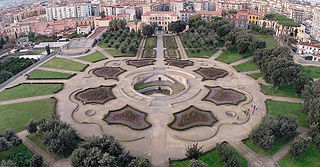
San Giorgio a Cremano is a primarily residential town and comune in the Metropolitan City of Naples, in Italy. It is located on the foothills of Mount Vesuvius to the west of the volcano, and is five kilometres to the south east of the centre of Naples. Most parts of the municipality command views of Mount Vesuvius, Mount Somma and the Bay of Naples.

Cosimo Fanzago was an Italian architect and sculptor, generally considered the greatest such artist of the Baroque period in Naples, Italy.

Ferdinando Fuga was an Italian architect who was born in Florence, and is known for his work in Rome and Naples. Much of his early work was in Rome, notably, the Palazzo della Consulta (1732–7) at the Quirinal, the Palazzo Corsini (1736–54), the façade of the Santa Maria Maggiore (1741–3), and the Church of Sant'Apollinare (1742–8). He later moved to Naples and notably designed the Albergo de'Poveri (1751–81), the façade of the Church of the Gerolamini, and that of the Palazzo Giordano.

Santa Maria del Carmine is a church in Naples, Italy. It is at one end of Piazza Mercato, the centre of civic life in Naples for many centuries until it was cut off from the rest of the city by urban renewal in 1900. The church was founded in the 13th century by Carmelite friars driven from the Holy Land in the Crusades, presumably arriving in the Bay of Naples aboard Amalfitan ships. Some sources, however, place the original refugees from Mount Carmel as early as the eighth century. The church is still in use and the 75–metre bell tower is visible from a distance even amidst taller modern buildings.
Annibale Caccavello (1515–1595) was an Italian sculptor of the Renaissance, active in his native city of Naples.
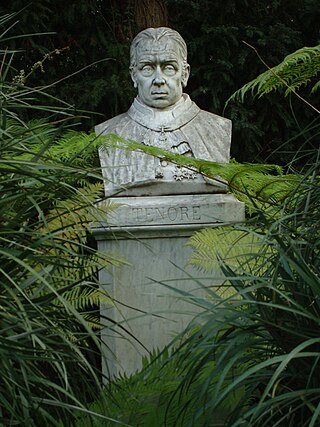
Michele Tenore was an Italian botanist active in Naples, Italy.

The University of Naples "L'Orientale" is a university located in Naples, Italy. Founded in 1732 by Matteo Ripa, it is the oldest school of Sinology and Oriental Studies of the European continent. It is organized in three departments, and is the main university in Italy specializing in the study of non-European languages and cultures, with research and studies agreements with universities all over the world. It is one of the top universities in the world regarding Asian cultures and languages.

The Ospedale degli Incurabili or Complesso degli Incurabili is an ancient and prominent hospital complex located on Via Maria Longo in central Naples, Italy. Part of the complex, including the remarkable pharmacy, are now the Museo delle arti sanitarie of Naples.

The church of Santa Maria di Montesanto and the annexed monastery were built in Naples, Italy, by a community of Carmelite friars that had its origins in Montesanto, Sicily.
Santa Maria Assunta dei Pignatelli is a deconsecrated Roman Catholic church located at the end of Via Nilo in Naples, region of Campania, Italy. In the small piazza in front of the church is an ancient Roman statue of the Nile God. It's located near the Santi Marco e Andrea a Nilo church.
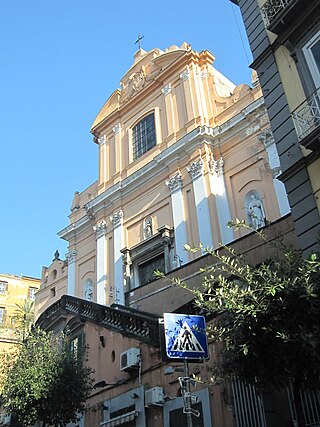
Santa Teresa degli Scalzi is a church in Naples, Italy, located in via Santa Teresa degli Scalzi, a wide street opened during 1806–1810, to connect the historic center of Naples to the zone of Capodimonte. The church is generally closed to the public.
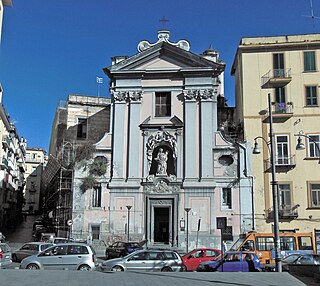
Santa Maria del Rosario alle Pigne is a church located near Piazza Cavour in Naples, Italy.

Santa Maria Donnalbina is a church located on the street of the same name in Naples, Italy.

Michelangelo Naccherino was an Italian sculptor and architect, active mainly in the Kingdom of Naples, Italy.
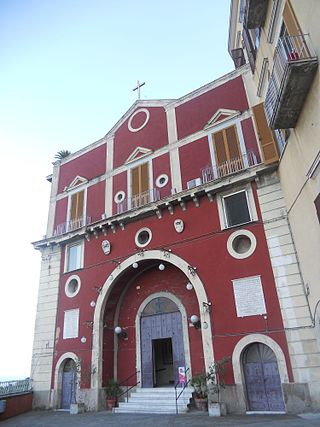
Santa Maria del Parto a Mergellina is a church located in the quartiere of Chiaia in Naples, Italy. The church is peculiarly perched on top of a private building and accessed by a stairway, placed behind a restaurant located in piazza Mergellina.
Raffaelle Spanò (1817–1863) was an Italian painter.

The Catacombs of Saint Gaudiosus are underground paleo-Christian burial sites, located in the northern area of the city of Naples.
The Aprea-Cuccaro clan is a Camorra clan operating in the area of Barra, in the city of Naples.
















